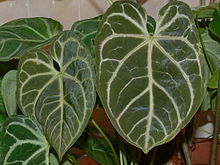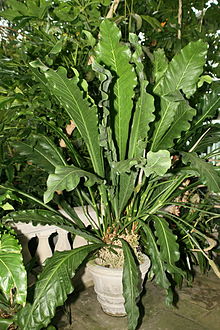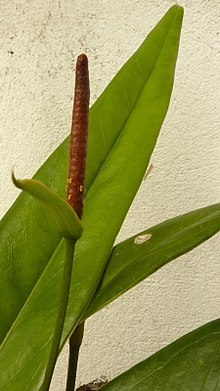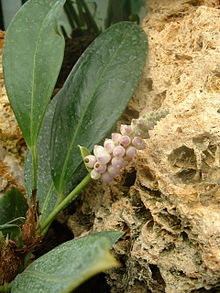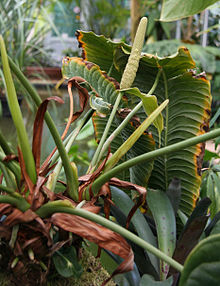Flamingo flowers
| Flamingo flowers | ||||||||||||
|---|---|---|---|---|---|---|---|---|---|---|---|---|
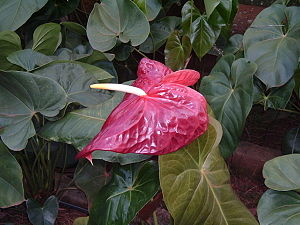
Great flamingo flower ( Anthurium andraeanum ) |
||||||||||||
| Systematics | ||||||||||||
|
||||||||||||
| Scientific name of the tribe | ||||||||||||
| Anthurieae | ||||||||||||
| Engl. | ||||||||||||
| Scientific name of the genus | ||||||||||||
| Anthurium | ||||||||||||
| Bulkhead |
The Flamingo flower ( Anthurium , then also Germanized anthurium called) form with more than 600 to more than 1,000 species, the only genus of the tribe Anthurieae and most species-rich genus of the family of the arum family (Araceae). This purely neotropical genus is common in tropical Central and South America and on the Caribbean islands. As houseplants , especially varieties of two types are used: The Great Flamingo flower ( Anthurium andraeanum ) and the Small flamingo flower ( Anthurium scherzerianum ).
description
Vegetative characteristics
Anthurium species grow as evergreen , perennial herbaceous plants . They thrive mostly epiphytically , sometimes terrestrially. The stem is short to long. Sometimes many roots at the nodes (be Nodien ) formed.
The mostly lanceolate lower leaves (Cataphylle) are durable or usually wither quickly to fibers. The foliage leaves, which are mostly concentrated in the upper area of the stem, are clearly divided into leaf sheath, petiole and leaf blade. The leaf sheaths are short. The mostly firm, stiff or flexible petioles have very different cross-sections depending on the species. The more or less leathery, rarely thin leaf blades have a wide range of shapes: mostly they are simple and elliptical to lanceolate, often with a heart-shaped base; sometimes they are lobed hand-shaped, whereby they can only be divided in the outer area or up to the base. The leaf blades are veined with a mostly raised midrib; the basal and lateral nerves often form a common nerve along the leaf margin.
Generative characteristics
At each node (Nodium) an inflorescence can be formed over a more or less long, leafless inflorescence stem . At the end of the inflorescence stem the spathe is usually at an oblique angle. The extended, recurved or sometimes upright spathe is not fused, mostly flat, lanceolate, rarely egg-shaped, often intensely colored and sometimes envelops the piston. The seated or short-stalked piston (spadix) is usually cylindrical, rarely club-shaped to spherical, usually tapers gradually to the tip, can be very differently colored and contains many flowers, spiral-shaped, densely arranged. The small, hermaphrodite flowers are protogynous. There are only four bracts . The pistil consists only of a two-chambered ovary on the tip of which the stigma is located as a slot-like depression. In each ovary chamber there are usually two, rarely three or more ovules . There are four fertile stamens . The stamens are flattened or fleshy. The anthers are usually wider than long. The pollen is colored differently depending on the species.
The infructescence is usually drooping, sometimes upright. The egg-shaped, oblong-egg-shaped, oblong or obovate berries are mostly juicy. They are colored very differently when ripe. The pericarp is thin and the translucent mesocarp is cute. The two-chambered berry usually contains one seed in each chamber. The somewhat flattened seeds usually have a sticky appendage on at least one end.
Systematics
The genus Anthurium was established in 1829 by Heinrich Wilhelm Schott in the Viennese magazine for art, literature, theater and fashion 1829 , Volume 3, p. 828. Lectotype species is Anthurium acaule (Jacq.) Schott . Synonyms for Anthurium Schott are Podospadix Raf. and Strepsanthera Raf. The genus Anthurium alone forms the tribe Anthurieae in the subfamily Pothoideae within the family Araceae. The tribe Anthurieae was established by Adolf Engler .
The genus Anthurium is divided into 18 sections:
- Section Belolonchium Schott
- Section Calomystrium Schott
- Section Cardiolonchium Schott
- Section Chamaerepium Schott : It contains only one species, Anthurium radicans Koch & Haage in eastern Brazil.
- Section Dactylophyllium Engler
- Section Decurrentia Croat
- Section Digitinervium Sodiro
- Gymnopodium Engler section : contains only one species, Anthurium gymnopus Griseb. , a rare Cuban endemic .
- Section Leptanthurium Schott
- Section Oxycarpium Schott
- Section pachyneurium
- Section Polyneurium Engler
- Polyphyllium Engler Section
- Section Porphyrochitonium Schott
- Section Schizoplacium Schott
- Section Semaeophyllum Schott
- Section tetraspermium
- Section Urospadix Engler
- Section Xialophyllium Schott
Types (selection)
Valid types (as of 2018):
A.
- Anthurium abajoense Croat & Zuluaga : It wasfirst describedfrom Colombia in 2015.
- Anthurium acanthospadix Croat & Oberle : It wasfirst describedfrom Colombia in 2004.
- Anthurium acaule (Jacq.) Schott : It occurs in Martinique .
- Anthurium acebeyae Croat : It was first described from Bolivia in 2005.
- Anthurium achupallense Croat : It wasfirst describedfrom Ecuador in 2010.
- Anthurium aciculare Croat : It was first described in 2018 from Colombia and Ecuador.
- Anthurium aciforme Croat & Delannay : It was first described from Ecuador in 2018.
- Anthurium acutangulum Engl .: Central America to northwestern Colombia
- Anthurium acutibacca Croat & MMMora : Colombia
- Anthurium acutifolium Engl . : Costa Rica and Panama. With two varieties.
- Anthurium acutissimum Engl .: Ecuador
- Anthurium acutum N.E.Br. : Brazil
- Anthurium aduncum Schott : Southeastern Brazil
- Anthurium affine Schott : Brazil
- Anthurium agnatum Schott : Honduras and Nicaragua
- Anthurium alatipedunculatum Croat & R.Baker : Costa Rica
- Anthurium alatum Engl .: Colombia
- Anthurium albertiae Croat & DCBay : It was first described in 2006 from Colombia.
- Anthurium albidum Sodiro : Ecuador
- Anthurium albispadix (Croat & J.Rodr.) Croat & O.Ortiz : It was first described from Ecuador in 2016.
- Anthurium albispatha Sodiro : Ecuador
- Anthurium albobueyense Croat : It wasfirst describedfrom Colombia in 2010.
- Anthurium albovirescens Sodiro : Northwest Ecuador
- Anthurium alcatrazense Nadruz & Cath. : It was first described in 2008 from the Brazilian state of São Paulo.
- Anthurium alcogolloi Croat : It wasfirst describedfrom Colombia in 2015.
- Anthurium alegriasense Engl .: Colombia
- Anthurium algentryi Croat : It was first described from Colombia in 2010.
- Anthurium alstonii Croat : It was first described from Colombia in 2010.
- Anthurium altaverapazense Croat & Hormell : It was first described from Guatemala in 2017.
- Anthurium alticola Croat : Costa Rica, Panama, Colombia
- Anthurium alturaense Croat : It wasfirst describedfrom Panama in 2013.
- Anthurium alvinii Croat & O. Ortiz : It was first described from Panama in 2017.
- Anthurium amargalense Croat & MMMora : Colombia
- Anthurium amnicola Dressler : Panama
- Anthurium amoenum Kunth : Western South America to Venezuela
- Anthurium anceps Sodiro : Ecuador
- Anthurium anchicayense Croat : Colombia
- Anthurium ancuashii Croat & Carlsen : Northern Peru
- Anthurium andicola Liebm. : The home is central and southern Mexico.
- Anthurium andinum Engl .: Colombia and Ecuador
- Large flamingo flower ( Anthurium andraeanum Linden ex André ): It is native to Colombia and Ecuador.
- Anthurium andreslovinense Matuda : Mexico
- Anthurium angelopolisense Croat : It was first described from Colombia in 2010.
- Anthurium angosturense Engl .: Colombia and northwestern Venezuela
- Anthurium angustatum (Kunth) Kunth : Venezuela
- Anthurium angustifolium Theófilo & Sakur. : Brazil
- Anthurium angustilaminatum Engl . : Ecuador. With two subspecies.
- Anthurium angustilobum Croat : Panama
- Anthurium angustisectum Engl . : Colombia
- Anthurium angustispadix Croat & R.Baker : Costa Rica and western Panama
- Anthurium annularum O. Ortiz , Croat & Baldini : It was first described from Panama in 2016.
- Anthurium anorianum Croat : Colombia
- Anthurium antioquiense Engl .: Colombia
- Anthurium antonioanum Croat : Costa Rica and Panama
- Anthurium antrophyoides Killip : Colombia
- Anthurium apaporanum R.E. Schul . : Southern Venezuela to Peru
- Anthurium apiaense Croat : It was first described from Colombia in 2011.
- Anthurium arbelaezii Croat : It was first described from Colombia in 2010.
- Anthurium archilae Croat : It was first described from Guatemala in 2017.
- Anthurium arenasense Croat & DCBay : It was first described from Colombia in 2006.
- Anthurium argyrostachyum Sodiro : Colombia and Ecuador
- Anthurium aripoense N.E.Br. : Trinidad and Venezuela
- Anthurium arisaemoides Madison : Ecuador to western Bolivia
- Anthurium aristatum Sodiro : Ecuador
- Anthurium armeniense Croat : Southwestern Guatemala
- Anthurium aroense G.S.Bunting : Venezuela
- Anthurium aromoense Croat : It was first described from Ecuador in 2013.
- Anthurium arusiense Croat & MMMora : Colombia
- Anthurium asplundii Croat : Ecuador
- Anthurium atramentarium Croat & Oberle : Colombia
- Anthurium atroguttatum Croat : It was first described from Ecuador in 2018.
- Anthurium atropurpureum R.E. Schul. & Maguire : It occurs in three varieties in tropical South America.
- Anthurium atroviride Sodiro : Ecuador
- Anthurium augustinum K. Koch & Lauche : Brazil
- Anthurium aureum Engl .: Colombia to northern Peru
- Anthurium auritum Sodiro : Ecuador
- Anthurium austin-smithii Croat & R.Baker : Nicaragua and Costa Rica.
- Anthurium aylwardianum Croat : It was first described from Peru in 2011.
B.
- Anthurium baguense Croat ; Northern Peru.
- Anthurium bakeri Hook. f. : It is common from Mexico to Ecuador and Guyana.
- Anthurium balaoanum Engl . : Ecuador.
- Anthurium baldinii Croat & O. Ortiz : It was first described from Panama in 2017.
- Anthurium balslevii Croat & J.Rodr. : Ecuador.
- Anthurium banderasense Croat : It was first described from Ecuador in 2013.
- Anthurium bantanum Croat & J.Deal : It was first described from Colombia in 2014.
- Anthurium barbacoasense Engl .: Colombia.
- Anthurium barclayanum Engl .: Western Ecuador to Peru.
- Anthurium barreranum Croat & DCBay : Colombia (Valla del Cauca).
- Anthurium barrieri Croat, Scherber. & G.Ferry : Peru.
- Anthurium barryi Croat : Panama to northwestern Colombia.
- Anthurium basirotundum Croat : Peru.
- Anthurium batistae Croat, O. Ortiz & Baldini : It was first described from Panama in 2015.
- Anthurium bayae Croat : Colombia (Vall del Cauca).
- Anthurium becerrae Croat : It was first described from Peru in 2013.
- Anthurium beckii Croat & Acebey : Bolivia.
- Anthurium bellum Schott : Origin: Brazil.
- Anthurium beltianum Standl. & LOWilliams : Nicaragua.
- Anthurium benavidesiae Croat : It was first described from Colombia in 2009.
- Anthurium benktsparrei Croat : It was first described from Ecuador in 2011.
- Anthurium bernardii Croat : Northwestern Venezuela.
- Anthurium berriozabalense Matuda : It occurs from Mexico to Belize .
- Anthurium berryi G.S.Bunting : Northwestern Venezuela.
- Anthurium besseae Croat : Bolivia.
- Anthurium betanianum Croat : Venezuela.
- Anthurium betsyae Croat : It was first described from Peru in 2013.
- Anthurium bicordoense Croat : It was first described from Colombia in 2011.
- Anthurium bimarginatum Sodiro : Ecuador.
- Anthurium binotii Linden : Brazil.
- Anthurium birdseyanum Croat : It was first described from Colombia in 2010.
- Anthurium bittneri Grayum. : Costa Rica to Panama.
- Anthurium blanquitense Croat : It was first described from Colombia in 2015.
- Anthurium bocainense Cath. & Nadruz : Brazil.
- Anthurium boekei Croat : It was first described from Ecuador in 2010.
- Anthurium bogneri Croat : It was first described from Ecuador in 2010.
- Anthurium bogotense Schott : It comes from Colombia.
- Anthurium bonplandii G.S.Bunting : Tropical South America.
- Anthurium boosianum Croat & G.Ferry : It was first described from Ecuador in 2011.
- Anthurium boudetii Nadruz : Brazil.
- Anthurium brachypodum Sodiro : Colombia and Ecuador.
- Anthurium bradeanum Croat & Grayum : Nicaragua, Costa Rica and Panama.
- Anthurium bragae Nadruz : Brazil.
- Anthurium bredemeyeri Schott : Venezuela.
- Anthurium brenesii Croat & R.Baker : Costa Rica.
- Anthurium brent-berlinii Croat : Peru.
- Anthurium breviapiculum Croat : It was first described from Panama in 2013.
- Anthurium brevipedunculatum Madison : Southeastern Colombia to Bolivia.
- Anthurium brevipes Sodiro : Western Colombia to Ecuador.
- Anthurium breviscapum Kunth : Tropical South America.
- Anthurium brevispadix Croat : Panama.
- Anthurium brittonianum Sodiro : Ecuador.
- Anthurium bromelicola Mayo & LPFélix : With two subspecies that occur in northeastern Brazil.
- Anthurium brownii mast. : Costa Rica to Ecuador.
- Anthurium bruxellense Croat : It was first described from Ecuador in 2019.
- Anthurium bucayanum Croat : Ecuador.
- Anthurium buchtienii K. Krause : Bolivia.
- Anthurium buganum Engl . : Colombia and Ecuador.
- Anthurium bullianum Engl .: Probably South America.
- Anthurium bullosum Sodiro : Ecuador.
- Anthurium burgeri Croat & R.Baker : Costa Rica.
- Anthurium bushii Croat : Ecuador.
C.
- Anthurium cabrerense Engl .: Colombia.
- Anthurium cabuyalense Croat & J.Rodr.Salvador.
- Anthurium cachabianum Sodiro
- Anthurium cachoeirense Theófilo & Sakur. : It wasfirst describedin 2015 from the Brazilian state of Espírito Santo .
- Anthurium cainarachense Engl.
- Anthurium caldodsonii Croat : It was first described from Ecuador in 2010.
- Anthurium calimense Croat & DCBay
- Anthurium callejasii Croat
- Anthurium caloveboranum Croat
- Anthurium campii Croat
- Anthurium camposii Sodiro
- Anthurium canaliculatum Sodiro
- Anthurium candolleanum Sodiro
- Anthurium caparaoense Temponi, Camelo & Nadruz : It was first described from Brazil in 2019.
- Anthurium caperatum Croat & R.Baker
- Anthurium caraboboense Croat
- Anthurium caramantae Engl.
- Anthurium carchiense Croat
- Anthurium cardenasii Croat : It was first described from Colombia in 2010.
- Anthurium carinatum Engl.
- Anthurium caripense G.S.Bunting
- Anthurium carmenense Croat : It was first described from Ecuador in 2018.
- Anthurium carneospadix Engl.
- Anthurium carnosum Croat & R.Baker
- Anthurium carpishense Croat
- Anthurium carrasquillanum Croat & O. Ortiz : It was first described from Panama in 2015.
- Anthurium cartiense Croat
- Anthurium cascajalense Croat : It was first described from Panama in 2013.
- Anthurium cartilagineum (Desf.) Kunth (Syn .: Anthurium appunianum Schott )
- Anthurium cataniapoense Croat
- Anthurium caucanum Engl.
- Anthurium caucavallense Croat
- Anthurium caulorrhizum Sodiro
- Anthurium ceratiinum Diels
- Anthurium ceronii Croat
- Anthurium cerrateae Croat & Lingán
- Anthurium cerrobaulense Matuda
- Anthurium cerrocampanense Croat
- Anthurium cerrofrioense Croat & O.Ortiz : It was first described from Panama in 2017.
- Anthurium cerropelonense Matuda
- Anthurium cerropirrense Croat
- Anthurium cerrosantiagoense Croat & O.Ortiz : It was first described from Panama in 2017.
- Anthurium chacoense Croat
- Anthurium chamberlainii mast.
- Anthurium chamulense Matuda
- Anthurium chequitavense Croat : It was first described from Peru in 2012.
- Anthurium chiapasense Standl.
- Anthurium chimborazense Croat & Carlsen
- Anthurium chinchipense Croat & Lingán
- Anthurium chinimense Croat
- Anthurium chiriquense Standl.
- Anthurium chocoense Croat
- Anthurium chorense Engl.
- Anthurium chorranum Croat
- Anthurium christeliae Croat & O. Ortiz : It was first described from Panama in 2016.
- Anthurium chrysolithos Croat & Oberle
- Anthurium chucantiense O. Ortiz, Croat & Baldini : It was first described from Panama in 2016.
- Anthurium chucunesense Croat : It was first described from Colombia in 2009.
- Anthurium chuchubiense Croat : It was first described from Ecuador in 2019.
- Anthurium churchilliorum Croat : It was first described from Panama in 2013.
- Anthurium churutense Croat & Cornejo
- Anthurium cinereopetiolatum Croat
- Anthurium cipoense Temponi : It was first described from Brazil in 2011.
- Anthurium circinatum Croat
- Anthurium cirinoi Croat : It was first described from Colombia in 2010.
- Anthurium citrifolium Sodiro
- Anthurium clarinervium Matuda : The home is the Mexican state of Chiapas.
- Anthurium clarkei Croat : It was first described in 2010 and occurs in Ecuador and Peru.
- Anthurium clathratum Sodiro
- Anthurium clavatum Croat & R.Baker
- Anthurium clavigerum Poepp. , Home: Colombia
- Anthurium cleistanthum G.M.Barroso
- Anthurium clidemioides Standl.
- Anthurium cobbiae Croat & Delannay : It was first described from Ecuador in 2018.
- Anthurium coclense Croat
- Anthurium cocornaense Croa t: It was first described from Colombia in 2010.
- Anthurium codajasii G.M.Barroso
- Anthurium coerulescens Engl.
- Anthurium cogolloanum Croat & MMMora
- Anthurium coleomischum Gilli
- Anthurium coleorrhiza Croat & DCBay
- Anthurium collettianum Croat : It was first described from Ecuador in 2010.
- Anthurium collinsii Croat
- Anthurium colonchense Croat & Cornejo
- Anthurium colonense Croat
- Anthurium colonicum K. Krause
- Anthurium coloradense Croat
- Anthurium comtum Schott
- Anthurium concinnatum Schott
- Anthurium concolor K. Krause
- Anthurium conjunctum K. Krause
- Anthurium consimile Schott
- Anthurium consobrinum Schott
- Anthurium conspicuum Sodiro
- Anthurium constrictum Croat & Carlsen
- Anthurium conterminum Sodiro
- Anthurium corallinum Poepp.
- Anthurium cordatotriangulum Matuda
- Anthurium cordatum (L.) Schott
- Anthurium cordifolium (Raf.) Kunth
- Anthurium cordiforme Sodiro
- Anthurium cordobense Croat & DCBay
- Anthurium cordulatum Sodiro
- Anthurium coriaceum G.Don : The home is Brazil.
- Anthurium coripatense N.E.Br. ex Engl.
- Anthurium correae Croat
- Anthurium corrugatum Sodiro : It is distributed from Panama to Ecuador.
- Anthurium cotejense Croat : It was first described from Colombia in 2010.
- Anthurium cotobrusii Croat & R.Baker
- Anthurium cowanii Croat
- Anthurium crassifolium N.E.Br.
- Anthurium crassilaminum Croat
- Anthurium crassinervium (Jacq.) Schott : It occurs in two varieties from Colombia to Venezuela and Curaçao .
- Anthurium crassiradix Croat
- Anthurium crassitepalum Croat
- Anthurium crassivenium Engl.
- Anthurium cremersii G.S.Bunting ex Croat : It wasfirst describedfrom French Guiana in 2010.
- Anthurium crenatum (L.) Kunth : The range extends from the Dominican Republic to the Virgin Islands .
- Anthurium croatii Madison
- Anthurium cronembergerae Nadruz & Temponi : It was first described from Brazil in 2014.
- Crystal tail flower ( Anthurium crystallinum Linden & André ): It is common from Panama to Colombia, Curacao
- Anthurium cuasicanum Croat
- Anthurium cubense Engl.
- Anthurium cucullispathum Croat
- Anthurium cultrifolium Schott
- Anthurium cupreonitens Engl.
- Anthurium cupreum Engl.
- Anthurium cupulispathum Croat & J.Rodr.Salvador : The home is Colombia and Ecuador.
- Anthurium curicuriariense Croat
- Anthurium curtipedunculum Croat : It was first described in 2015 from Colombia.
- Anthurium curtispadix Croat
- Anthurium curvilaminum Croat
- Anthurium curvispadix Croat
- Anthurium cuspidatum mast.
- Anthurium cuspidiferum Sodiro
- Anthurium cutucuense Madison
- Anthurium cuyabenoense Croat
- Anthurium cylindratum Croat & DCBay
- Anthurium cymbiforme N.E.Br.
- Anthurium cymbispatha Sodiro
D.
- Anthurium dabeibaense Croat : It was first described from Colombia in 2015.
- Anthurium daguense Engl.
- Anthurium darcyi Croat
- Anthurium davidsei Croat
- Anthurium davidsoniae Standl.
- Anthurium debile-emarginatum Croat : It was first described from Ecuador in 2018.
- Anthurium debilipeltatum Croat
- Anthurium debilis Croat & DCBay
- Anthurium decipiens A.Hay & M.Cedeño : It was first described from Colombia in 2019.
- Anthurium decurrens Poepp.
- Anthurium decursivum Croat : It was first described from Ecuador in 2019.
- Anthurium deflexum Engl.
- Anthurium delannayi Croat : It was first described from Colombia in 2010.
- Anthurium deminutum Croat : It was first described from Panama in 2013.
- Anthurium dendrobates Sodiro
- Anthurium denudatum Engl.
- Anthurium diazii Croat
- Anthurium digitatum (Jacq.) G.Don : It is common in Venezuela and Tobago .
- Anthurium diversicaudex Croat : It was first described from Ecuador in 2011.
- Anthurium dolichocnemum Croat
- Anthurium dolichophyllum Sodiro
- Anthurium dolichostachyum Sodiro : It occurs in southern Colombia and Ecuador.
- Anthurium dombeyanum Brongn. ex Engl.
- Anthurium dominicense Schott
- Anthurium donovaniae Croat : It was first described from Ecuador in 2013.
- Anthurium dorbayae Croat : It was first described from Colombia in 2010.
- Anthurium draconopterum Sodiro
- Anthurium dressleri Croat
- Anthurium dukei Croat
- Anthurium durandii Engl.
- Anthurium dussii Engl.
- Anthurium dwyeri Croat
- Anthurium dylanii Croat : It was first described from Colombia in 2010.
E.
- Anthurium ecuadorense Engl.
- Anthurium effusilobum Croat
- Anthurium effusispathum Croat : It was first described from Ecuador in 2008.
- Anthurium eggersii Engl .: Home is western Ecuador.
- Anthurium eichleri Engl.
- Anthurium elisalevyae Croat : It was first described from Ecuador in 2019.
- Anthurium elquincense Croat : It was first described from Colombia in 2015.
- Anthurium emarginatum Baker in WWSaunders
- Anthurium eminens Schott
- Anthurium ensifolium Bogner & EGGonç.
- Anthurium ericae Diels
- Anthurium ernestii Engl.
- Anthurium erskinei Mayo
- Anthurium erythrospadix Nadruz, Camelo & Temponi : It was first described from Brazil in 2018.
- Anthurium erythrospathaceum Nadruz & Theófilo : It was first described from Brazil in 2019.
- Anthurium erythrostachyum Croat
- Anthurium esmeraldense Sodiro
- Anthurium espinae Croat : It was first described from Colombia in 2010.
- Anthurium espiranzaense Croat & Zuluaga : It was first described from Colombia in 2015.
- Anthurium eximium Engl.
- Anthurium expansum Gleason
- Anthurium exstipulatum Sodiro
F.
- Anthurium fasciale Sodiro
- Anthurium fatoense K. Krause
- Anthurium faustomirandae Pérez-Farr. & Croat
- Anthurium fendleri Schott
- Anthurium fernandezii Croat
- Anthurium filamatamaense Croat & O.Ortiz : It was first described from Costa Rica in 2016.
- Anthurium filiforme Engl.
- Anthurium flavescens Poepp.
- Anthurium flavidum N.E.Br.
- Anthurium flavolineatum Sodiro
- Anthurium flavoviride Engl.
- Anthurium flexile Schott
- Anthurium folsomianum Croat
- Anthurium fontellanum Nadruz & Leoni
- Anthurium fontoides R.E. Schul .
- Anthurium foreroanum Croat
- Anthurium forgetii N.E.Br. : It occurs in Colombia.
- Anthurium formosum Schott
- Anthurium fornicifolium Croat
- Anthurium fortunatum G.S.Bunting
- Anthurium fosteri Croat
- Anthurium fragae Nadruz
- Anthurium fragrans Croat & DCBay
- Anthurium fragrantissimum Croat
- Anthurium fraseri Engl.
- Anthurium friedrichsthalii Schott
- Anthurium frontinoense Croat & Zuluaga : It was first described from Colombia in 2015.
- Anthurium funiferum Klotzsch & H.Karst. ex Engl.
- Anthurium furcatum Sodiro
- Anthurium fuscopunctatum Sodiro
- Anthurium fusiforme Croat
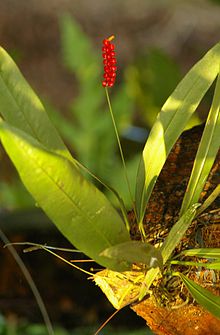
G
- Anthurium gaffurii Sodiro
- Anthurium galactospadix Croat
- Anthurium galeanoae Croat & MMMora
- Anthurium galeottii K. Koch : It occurs in the Brazilian state of Rio de Janeiro.
- Anthurium galileanum Croat
- Anthurium gaskinii Croat : It was first described from Colombia in 2010.
- Anthurium gaudichaudianum Kunth
- Anthurium gehrigeri Croat
- Anthurium geitnerianum A. Regel
- Anthurium gelpii Croat : It was first described from Ecuador in 2018.
- Anthurium genferryae Croat : It was first described from Ecuador in 2011.
- Anthurium geniculatum Sodiro
- Anthurium gentryi Croat
- Anthurium gerherrerae Croat : It was first described from Colombia in 2009.
- Anthurium giganteum Engl.
- Anthurium ginesii Croat
- Anthurium giraldoi Croat
- Anthurium gladiifolium Schott
- Anthurium glanduligerum Engl.
- Anthurium glaucophyllum Sodiro
- Anthurium glaucospadix Croat
- Anthurium globosum Croat
- Anthurium gomesianum Nadruz
- Anthurium gonzalezii Croat
- Anthurium gracile (Rudge) Lindl. : The range includes Trinidad and central and southern tropical America.
- Anthurium gracililaminum Croat
- Anthurium gracilipedunculatum K. Krause
- Anthurium gracilispadix Croat
- Anthurium gracilistipum Croat : The species first described in 2009 occurs from Colombia to Ecuador.
- Anthurium grande W. Bull
- Anthurium grandicataphyllum Croat & MMMora
- Anthurium grandifolium (Jacq.) Kunth : Home is Jamaica and the Lesser Antilles .
- Anthurium granulineare Croat : The species was first described from Panama in 2013.
- Anthurium grex-avium Madison
- Anthurium griseosessile Croat : It was first described from Ecuador in 2018.
- Anthurium gualeanum Engl.
- Anthurium guanacense Engl.
- Anthurium guanchezii G.S.Bunting
- Anthurium guanghuae Croat : The species was first described from Panama in 2013.
- Anthurium guatemalense Croat
- Anthurium guayaquilense Engl.
- Anthurium gustavii rule
- Anthurium gymnopus Griseb.

H
- Anthurium hacumense Engl.
- Anthurium hagsaterianum Hague
- Anthurium halmoorei Croat
- Anthurium haltonii Croat : The species was first described from Panama in 2013.
- Anthurium hamiltonii Croat & Lingán
- Anthurium hammelii Croat
- Anthurium hannoniae Croat : It was first described from Ecuador in 2019.
- Anthurium harrisii (Graham) G.Don : It occurs in the Brazilian state of Rio de Janeiro.
- Anthurium hartmanii Croat & O. Ortiz : It was first described from Panama in 2017.
- Anthurium hastifolium Sodiro
- Anthurium hatschbachii E.G. Gonç. : The species was first described from Brazil in 2011.
- Anthurium hebetatilaminum Croat & J.Rodr.Salvador
- Anthurium hebetatum Croat
- Anthurium hempeanum Croat : The species was first described from Colombia in 2015.
- Anthurium henryi Croat : The species was first described from Panama in 2013.
- Anthurium herrerae Croat & P.Huang : The species was first described from Colombia in 2009.
- Anthurium herthae K. Krause
- Anthurium hieronymi Engl.
- Anthurium hinoideum Croat & DCBay
- Anthurium hodgei Croat, MMMora & Oberle
- Anthurium hoehnei K. Krause
- Anthurium hoffmannii Schott
- Anthurium holm-nielsenii Croat
- Anthurium holquinianum Croat & DCBay
- Anthurium hookeri Kunth : It occurs from St. Lucia to northern South America.
- Anthurium hornitense Croat
- Anthurium horridum Croat : The species was first described from Panama in 2013.
- Anthurium huacamayoense Croat
- Anthurium huallagense Engl.
- Anthurium huampamiense Croat
- Anthurium huanucense Engl.
- Anthurium huashikatii Croat
- Anthurium huautlense Matuda
- Anthurium huberi G.S.Bunting ex Croat : The species was first described from Venezuela in 2010.
- Anthurium huixtlense Matuda
- Anthurium humboldtianum Kunth
- Anthurium humoense Croat
- Anthurium hutchisonii Croat
- Anthurium hygrophilum Engl.
I.
- Anthurium ianthinopodum (Engl.) Nadruz & Mayo
- Anthurium icanense G.M.Barroso
- Anthurium idmense K. Krause
- Anthurium individuellepidum Schott
- Anthurium iltisii Croat
- Anthurium imazaense Croat : The species was first described from Peru in 2013.
- Anthurium imperiale Miq. ex Schott
- Anthurium impolitoellipticum Croat : It was first described from Ecuador in 2019.
- Anthurium impolitum Croat
- Anthurium incomptum Madison
- Anthurium inconspicuum N.E.Br.
- Anthurium incurvatum Engl.
- Anthurium incurvum Engl.
- Anthurium infectorium R.E. Schul.
- Anthurium ingramii Croat : The species was first described from Panama in 2013.
- Anthurium intactum Croat & O. Ortiz : It was first described in 2016. It occurs from Costa Rica to northwestern Colombia.
- Anthurium intermedium Kunth
- Anthurium interruptum Sodiro
- Anthurium inzanum Engl.
- Anthurium ionanthum Croat
- Anthurium iramireziae G.S.Bunting
- Anthurium isidroense Croat & DCBay
J
- Anthurium jaimeanum Croat & Cerón : The species was first described from Ecuador in 2014.
- Anthurium jaramilloi Croat & J.Rodr.Salvador
- Anthurium jefense Croat
- Anthurium jenmanii Engl.
- Anthurium jesusii Croat : The species was first described in 2010 and occurs from Colombia to Ecuador.
- Anthurium jilekii Schott
- Anthurium jimenae Croat
- Anthurium joaquinense Croat & DC Bay
- Anthurium johnmackii Croat & Oberle
- Anthurium johnsoniae Croat
- Anthurium josei Croat
- Anthurium juanguillermoi Croat : The species was first described from Colombia in 2015.
- Anthurium julianii G.S.Bunting
- Anthurium julospadix Sodiro
- Anthurium jureianum Cath. & Olaio
K
- Anthurium kajekaii Croat : The species was first described from Ecuador in 2010.
- Anthurium kallunkiae Croat
- Anthurium kamemotoanum Croat
- Anthurium kareniae Croat : The species was first described from Panama in 2013.
- Anthurium karstenianum Engl.
- Anthurium kastelskii Schott
- Anthurium kayapii Croat
- Anthurium keatingii Croat : The species was first described from Colombia in 2009.
- Anthurium kinsingeriae Croat : It was first described from Ecuador in 2019.
- Anthurium kurziae Croat
- Anthurium krukovii Croat
- Anthurium kugkumasii Croat
- Anthurium kunayalense Croat & Vannini : The species was first described from Panama in 2010.
- Anthurium kunthii Poepp.
- Anthurium kusuense Croat
L.
- Anthurium lacerdae Reitz
- Anthurium laciniosum Sodiro
- Anthurium lactifructum Croat
- Anthurium lakei Croat & P.Huang : The species was first described from Colombia in 2009.
- Anthurium laminense Croat : The species was first described from Panama in 2013.
- Anthurium lancea Sodiro
- Anthurium lancetillense Croat
- Anthurium lancifolium Schott
- Anthurium langendoenii Croat & DCBay
- Anthurium langsdorffii Schott
- Anthurium lanjouwii A.MEJonker & Jonker
- Anthurium lasabanetaense Croat & O.Ortiz : It was first described from Panama in 2016.
- Anthurium latemarginatum Sodiro
- Anthurium latissimum Engl.
- Anthurium laucheanum K. Koch
- Anthurium lautum Croat & DCBay
- Anthurium lechlerianum Schott
- Anthurium lehmannii Engl.
- Anthurium lennartii Croat
- Anthurium lentii Croat & R.Baker
- Anthurium leonianum Sodiro
- Anthurium leonii E.G. Gonç.
- Anthurium leptocaule Croat
- Anthurium leuconeurum Lem. : It occurs in the Mexican state of Chiapas.
- Anthurium leveaui Croat
- Anthurium lezamae Matuda
- Anthurium lhotzkyanum Schott
- Anthurium libanoense Croat : The species was first described from Colombia in 2010.
- Anthurium licium Croat & Oberle
- Anthurium lievenii rule ex Engl.
- Anthurium ligulare Croat
- Anthurium lilacinum G.S.Bunting
- Anthurium lilafructum Croat : The species was first described from Panama in 2013.
- Anthurium limonense Grayum
- Anthurium lindenianum K. Koch & Augustin
- Anthurium lindmanianum Engl.
- Anthurium lineolatum Sodiro
- Anthurium linganii Croat
- Anthurium lingua Sodiro
- Anthurium linguifolium Engl.
- Anthurium llanense Croat
- Anthurium llewellynii Croat
- Anthurium lloense Sodiro
- Anthurium loefgrenii Engl.
- Anthurium lojtnantii Croat
- Anthurium longeinternodum Croat : It was first described from Ecuador in 2019.
- Anthurium longicaudatum Engl.
- Anthurium longicuspidatum Engl.
- Anthurium longifolium (Hoffm.) G.Don
- Anthurium longigeniculatum Engl.
- Anthurium longipeltatum Matuda
- Anthurium longipes N.E.Br.
- Anthurium longispadiceum K. Krause
- Anthurium longissimilobum Croat
- Anthurium longissimum Pittier
- Anthurium longistamineum Engl.
- Anthurium longistipitatum Croat
- Anthurium longiusculum Croat
- Anthurium loretense Croat
- Anthurium louisii Croat & R.Baker
- Anthurium lucens Standl.
- Anthurium lucidum Kunth
- Anthurium lucioi Nadruz
- Anthurium lucorum Engl.
- Anthurium luschnathianum Kunth
- Anthurium luteospathum Croat : The species was first described from Panama in 2013.
- Anthurium lutescens Engl.
- Anthurium luteynii Croat
- Anthurium luxurians Croat & RNCirino
- Anthurium lygrum Croat & DCBay
- Anthurium lynniae Croat : The species was first described from Ecuador in 2010.
M.
- Anthurium maasii Croat : The species was first described from Colombia in 2010.
- Anthurium macarenense R.E. Schul . & Idrobo
- Anthurium macbridei K. Krause
- Anthurium macdanielii Croat
- Anthurium machetioides Matuda
- Anthurium macleanii Schott
- Anthurium macphersonii Croat & Oberle
- Anthurium macrocephalum R.E. Schul.
- Anthurium macrolonchium Sodiro
- Anthurium macrophyllum (Sw.) Schott
- Anthurium macropodum E.G. Gonç. : The species was first described from Brazil in 2012.
- Anthurium macrospadix Lem.
- Anthurium macrourum Sodiro
- Anthurium maculosum Sodiro
- Anthurium madisonianum Croat
- Anthurium magdae Croat & Lingán
- Anthurium magnificum Linden , home: The home is Colombia.
- Anthurium magnifolium Croat & J.Rodr.Salvador
- Anthurium magrewii Croat : The species was first described from Ecuador in 2013.
- Anthurium maguirei A.D. Hawkes
- Anthurium malagaense Croat & DCBay
- Anthurium malianum Croat
- Anthurium manabianum Croat
- Anthurium mancuniense C.D.Adams
- Anthurium mansellii Croat : It was first described from Ecuador in 2019.
- Anthurium manuanum Croat
- Anthurium marcusianum Theófilo, L. Kollmann & Sakur. : It was first described from Brazil in 2019.
- Anthurium marense K. Krause
- Anthurium margaricarpum Sodiro
- Anthurium marginellum Sodiro
- Anthurium mariae Croat & Lingán
- Anthurium maricense Nadruz & Mayo
- Anthurium marinoanum Croat
- Anthurium marleenianum Croat : The species was first described from Ecuador in 2011.
- Anthurium marmoratum Sodiro
- Anthurium martae Croat & Castaño : The species was first described in 2009 and occurs from Colombia to northwestern Venezuela.
- Anthurium martianum K.Koch & Kolb : The distribution area ranges from Guyana to Suriname.
- Anthurium martinellii Nadruz & Theófilo : It was first described from Brazil in 2019.
- Anthurium masfense Sodiro
- Anthurium mateoi Croat & N.Altam. : The species was first described from Peru in 2012.
- Anthurium maximilianii Schott
- Anthurium maximum (Desf.) Engl.
- Anthurium megapetiolatum E.G. Gonç.
- Anthurium melampyi Croat : The species was first described in 2009 and occurs from Colombia to Ecuador.
- Anthurium melanochlorum Croat : It was first described in 2018 from Colombia and Ecuador.
- Anthurium melastomatis Croat
- Anthurium membranaceum Sodiro
- Anthurium mendietae Croat : The species was first described from Ecuador in 2010.
- Anthurium merlei Croat : The species was first described from Venezuela in 2010.
- Anthurium metallicum Linden ex Schott
- Anthurium miaziense Croat : The species was first described from Venezuela in 2010.
- Anthurium michelii Guillaumin
- Anthurium microphyllum (Raf.) G.Don
- Anthurium microspadix Schott
- Anthurium mikeneei Croat : It was first described from Panama in 2017.
- Anthurium minarum Sakuragui & Mayo
- Anthurium mindense Sodiro
- Anthurium miniatum Sodiro
- Anthurium misturatum Croat : It was first described in 2018 from northwest Ecuador.
- Anthurium modicum Croat & Oberle
- Anthurium molaui Croat : The species was first described from Ecuador in 2011.
- Anthurium molle E.G. Gonç. & JGJardim : The species was first described from Brazil in 2010.
- Anthurium mongonense Croat : It was first described from Ecuador in 2018.
- Anthurium montanum Hemsl.
- Anthurium monteagudoi Croat & N.Altam. : The species was first described in 2012 and occurs from Peru to Bolivia.
- Anthurium monteazulense Croat, O. Ortiz & Baldini : The species was first described from Panama in 2015.
- Anthurium monteverdense Croat & R.Baker
- Anthurium monticola Engl.
- Anthurium monzonense Engl.
- Anthurium moonenii Croat & EGGonç.
- Anthurium morae Croat
- Anthurium morii Mayo & Haigh : The species was first described from Brazil in 2011.
- Anthurium moronense Croat & Carlsen
- Anthurium mostaceroi Croat
- Anthurium mourae Engl.
- Anthurium mucuri E.G. Gonç . & LFAPaula : It was first described from Brazil in 2016.
- Anthurium multinervium Engl.
- Anthurium multisulcatum Engl.
- Anthurium munchiquense Croat : The species was first described from Colombia in 2010.
- Anthurium myosuroides (Kunth) Endl.
- Anthurium myosurus Sodiro
N
- Anthurium nakamurae Matuda
- Anthurium nangaritense Croat : The species was first described from Ecuador in 2010.
- Anthurium nanum R.E. Schul.
- Anthurium napaeum Engl.
- Anthurium narae Nadruz, Camelo & Temponi : It was first described from Brazil in 2018.
- Anthurium narinoense Croat
- Anthurium narvaezii Croat : It was first described from Ecuador in 2018.
- Anthurium navasii Sodiro
- Anthurium naviculare Cath. & Nadruz
- Anthurium nelsonii Croat
- Anthurium nemorale Sodiro
- Anthurium nemoricola R.E. Schul . & Maguire
- Anthurium nervatum Croat
- Anthurium nestorpazii Croat & P.Huang : The species was first described from Colombia in 2009.
- Anthurium nicolasianum Engl.
- Anthurium nigrescens Engl.
- Anthurium nigropunctatum Croat & J.Rodr.Salvador
- Anthurium niqueanum Croat
- Anthurium nitens Sodiro
- Anthurium nitidulum Engl.
- Anthurium nitidum Benth.
- Anthurium nizandense Matuda
- Anthurium novitaense Croat : The species was first described from Colombia in 2010.
- Anthurium nubicola G.S.Bunting
- Anthurium nutibarense Croat
- Anthurium nymphaeifolium K.Koch & CDBouché : It is native to Venezuela and northern Colombia.
O
- Anthurium obliquatum Schott
- Anthurium oblongocordatum Engl.
- Anthurium obpyriforme Leimbeck
- Anthurium obscurinervium Croat
- Anthurium obtusatum Engl.
- Anthurium obtusifolium (WTAiton) G.Don
- Anthurium obtusilobum Schott
- Anthurium obtusum (Engl.) Grayum : It occurs in two subspecies in Central America and in tropical South America.
- Anthurium occidentale Sodiro
- Anthurium ochranthum K. Koch
- Anthurium ochreatum Sodiro
- Anthurium ocotepecense Matuda
- Anthurium oerstedianum Schott
- Anthurium oreodoxum Sodiro
- Anthurium oreophilum Sodiro
- Anthurium organense Engl.
- Anthurium orientale Sodiro
- Anthurium orteganum Engl.
- Anthurium ottobuchtienii Croat
- Anthurium ottonis K. Frill
- Anthurium ovatifolium Engl.
- Anthurium ovidioi Croat : The species was first described from Colombia in 2010.
- Anthurium oxyanthum Croat & DCBay
- Anthurium oxybelium Schott : The home is western South America.
- Anthurium oxycarpum Poepp.
- Anthurium oxyphyllum Sodiro
- Anthurium oxystachyum Croat
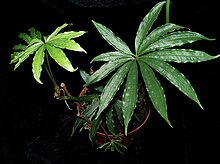
P
- Anthurium pachyspathum K. Krause
- Anthurium pageanum Croat
- Anthurium pahumense Cerón & Croat : The species was first described from Ecuador in 2014.
- Anthurium palacioanum Croat
- Anthurium palenquense Croat
- Anthurium pallatangense Engl.
- Anthurium pallens Schott
- Anthurium pallidicaudex Croat & MMMora
- Anthurium pallidiflorum Engl.
- Anthurium palmatum (L.) Schott : It is widespread on the Caribbean islands and in Colombia.
- Anthurium paloraense Croat : The species was first described from Ecuador in 2013.
- Anthurium palosecense Croat & O.Ortiz : It was first described from Panama in 2016.
- Anthurium paludosum Engl.
- Anthurium panamense Croat
- Anthurium panduriform Schott
- Anthurium pandurilaminum Croat : It was first described from Ecuador in 2019.
- Anthurium papillilaminum Croat
- Anthurium paradisicum G.S.Bunting
- Anthurium paraguasense Croat : The species was first described from Colombia in 2010.
- Anthurium paraguayense Engl .: It occurs in two varieties from Brazil to Argentina.
- Anthurium parambae Sodiro
- Anthurium parasiticum (Vell.) Stellfeld
- Anthurium pariense G.S.Bunting
- Anthurium parile N.E.Br. ex Engl.
- Anthurium parvispathum Hemsl.
- Anthurium parvum N.E.Br.
- Anthurium pastasanum Diels
- Anthurium patens Croat : The species was first described from Ecuador in 2010.
- Anthurium pauciflorum Croat
- Anthurium paucinerve Sodiro
- Anthurium payaminoense Croat & Lingán
- Anthurium pazii Croat : The species was first described from Colombia in 2009.
- Anthurium pedatoradiatum Schott : It is distributed in two subspecies in southern Mexico.
- Anthurium patum (Kunth) Endl. ex Kunth
- Anthurium pedrazae Croat & Zuluaga : The species was first described from Colombia in 2015.
- Anthurium pedunculare Sodiro
- Anthurium pellucidopunctatum Sodiro
- Anthurium peltatum Poepp.
- Anthurium peltigerum Sodiro
- Anthurium penae Croat
- Anthurium pendens Croat
- Anthurium pendulifolium N.E.Br.
- Anthurium pendulispadix Croat : The species was first described in 2009 and occurs from Colombia to Ecuador.
- Anthurium penningtonii Croat
- Anthurium penonomense Croat : The species was first described from Panama in 2013.
- Anthurium pentaphyllum (Aubl.) G.Don
- Anthurium perijanum G.S.Bunting
- Anthurium perviride Croat & DCBay
- Anthurium pescadilloense Croat
- Anthurium petiolicarinatum Nadruz, Mantovani & Carlsen : It was first described from Brazil in 2019.
- Anthurium petrophilum K. Krause
- Anthurium phyllobaris Croat & DCBay
- Anthurium pichinchae Engl.
- Anthurium pichindense Croat : The species was first described from Colombia in 2010.
- Anthurium pilonense Reitz
- Anthurium pinkleyi Croat & Carlsen
- Anthurium pirottae Sodiro
- Anthurium pirrense Croat
- Anthurium pittieri Engl.
- Anthurium piurensis Croat & Lingán
- Anthurium planadense Croat : The species was first described from Colombia in 2009.
- Anthurium plantagineum Sodiro
- Anthurium platyglossum Sodiro
- Anthurium platyrhizum Croat
- Anthurium plowmanii Croat : The range extends from Peru to western Brazil and Paraguay.
- Anthurium plurisulcatum Sodiro
- Anthurium pluviaticum R.E. Schul .
- Anthurium podophyllum (Cham. & Schltdl.) Kunth
- Anthurium pohlianum Engl.
- Anthurium poloense Croat : The species was first described from Colombia in 2015.
- Anthurium polydactylum Madison
- Anthurium polynervium Temponi & Nadruz : The species was first described from Brazil in 2011.
- Anthurium polyneuron Sodiro
- Anthurium polyphlebium Sodiro
- Anthurium polyschistum R.E. Schul. & Idrobo : The home is Colombia and Ecuador.
- Anthurium polystictum Sodiro
- Anthurium porcesitoense Croat : The species was first described from Colombia in 2011.
- Anthurium potarense Gleason
- Anthurium pradoense Croat
- Anthurium praealtum Sodiro
- Anthurium pranceanum Croat
- Anthurium prolatum Croat & R.Baker
- Anthurium prominens Engl.
- Anthurium promininerve Croat & MMMora
- Anthurium protensum Schott
- Anthurium protrudens Croat : The species was first described from Colombia in 2009.
- Anthurium pseudonigrescens Croat : It was first described in 2018 from northwest Ecuador.
- Anthurium pseudospectabile Croat
- Anthurium pseudotalamancae Croat : It was first described from Ecuador in 2019.
- Anthurium psilostachyum Sodiro
- Anthurium ptarianum Steyerm.
- Anthurium puberulinervium Croat
- Anthurium puberulum Croat & Lingán
- Anthurium pucayacuense Croat
- Anthurium pulcachense Croat
- Anthurium pulchellum Engl.
- Anthurium pulidoae Croat : The species was first described from Colombia in 2010.
- Anthurium pulverulentum Sodiro
- Anthurium punctatum N.E.Br.
- Anthurium punkuyocense Croat : The species was first described from Peru in 2011.
- Anthurium purdieanum Schott
- Anthurium purpureospathum Croat
- Anthurium purpureum N.E.Br.
Q
- Anthurium queirozianum Nadruz : The species was first described from Brazil in 2012.
- Anthurium quinindense Croat : The species was first described from Ecuador in 2010.
- Anthurium quinonesiae Croat : The species was first described from Colombia in 2013.
- Anthurium quinquenervium (Kunth) Kunth
- Anthurium quinquesulcatum Sodiro
- Anthurium quipuscoae Croat
R.
- Anthurium radiatum Sodiro
- Anthurium radicans K. Koch & Haage : It is distributed in southern Brazil.
- Anthurium raimundii Mayo, Haigh & Nadruz : The species was first described from Brazil in 2011.
- Anthurium ramoncaracasii Stergios & Dorr
- Anthurium ramonense Engl. Ex K.Krause
- Anthurium ramosense Croat : The species was first described from Colombia in 2010.
- Anthurium ramosii Croat : The species was first described from Colombia in 2010.
- Anthurium ranchoanum Engl.
- Anthurium ravenii Croat & R.Baker
- Anthurium recavum Croat : The species was first described from Colombia in 2010.
- Anthurium redolens Croat
- Anthurium reflexinervium Croat
- Anthurium regale Linden , Origin: Peru
- Anthurium remotigeniculatum Croat
- Anthurium remotum Croat & DCBay
- Anthurium renteriae Croat : The species was first described from Colombia in 2010.
- Anthurium resectum Sodiro
- Anthurium restrepoae Croat : The species was first described from Colombia in 2009.
- Anthurium reticulatum Benth.
- Anthurium retiferum Standl. & Steyerm.
- Anthurium rhizophorum Sodiro
- Anthurium rhodorhizum Diels
- Anthurium ribeiroi Nadruz : The species was first described from Brazil in 2012.
- Anthurium ricaurtense Croat : The species was first described in 2009 and occurs from Colombia to Ecuador.
- Anthurium rigidifolium Engl.
- Anthurium rimbachii Sodiro
- Anthurium rioacimense Nadruz & Rabelo : The species was first described from Brazil in 2014.
- Anthurium riocojimiesense Croat : The species was first described from Ecuador in 2013.
- Anthurium riodocense Nadruz : The species was first described from Brazil in 2012.
- Anthurium riofrioi Sodiro
- Anthurium riograndicola Matuda
- Anthurium riojaense Croat : The species was first described from Peru in 2011.
- Anthurium rionegrense Matuda
- Anthurium riparium Engl.
- Anthurium rivulare Sodiro
- Anthurium rodvasquezii Croat : The species was first described from Peru in 2012.
- Anthurium rodrigueziae Croat
- Anthurium roezlii rule
- Anthurium rojasiae Croat
- Anthurium roraimense N.E.Br. ex Oliv.
- Anthurium roseonaviculare Croat & O.Ortiz : It was first described from Panama in 2016.
- Anthurium roseospadix Croat
- Anthurium rosselianum Croat : It was first described from Colombia in 2019.
- Anthurium rotundatum Croat & Carlsen
- Anthurium rotundilobum Engl.
- Anthurium rotundistigmatum Croat
- Anthurium roubikii Croat : The species was first described from Panama in 2013.
- Anthurium rubrifructum Croat
- Anthurium rubrivellus Croat & DCBay
- Anthurium rugulosum Sodiro
- Anthurium rupestre Sodiro
- Anthurium rupicola Croat
- Anthurium rzedowskii Croat
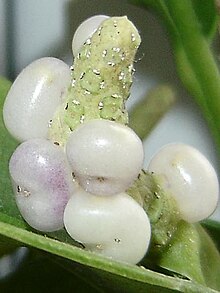
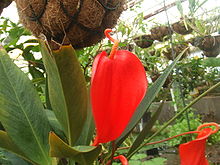
S.
- Anthurium saccardoi Sodiro
- Anthurium sagawae Croat
- Anthurium sagittal Sodiro
- Anthurium sagittaria Linden ex Schott
- Anthurium sagittatum (Sims) G.Don
- Anthurium sagittellum Sodiro
- Anthurium sakuraguianum Nadruz & Temponi : The species was first described from Brazil in 2014.
- Anthurium salgarense Croat
- Anthurium salvadorense Croat
- Anthurium salvinii Hemsl.
- Anthurium samamaense Croat & Cornejo
- Anthurium sanctifidense Croat
- Anthurium sanguineum Engl.
- Anthurium santamariae Croat & O.Ortiz : It was first described from Panama in 2017.
- Anthurium santaritensis Nadruz & Croat
- Anthurium santiagoense Croat
- Anthurium sapense Croat
- Anthurium sarmentosum Engl.
- Anthurium sarukhanianum Croat & Haager
- Anthurium scaberulum Sodiro
- Anthurium scandens (Aubl.) Engl .: It is distributed in two subspecies from southern Mexico via Central America and the Caribbean islands to tropical South America.
- Small flamingo flower ( Anthurium scherzerianum Schott ): It occurs in Costa Rica.
- Anthurium badendalii Kunth
- Anthurium schottianum Croat & R.Baker
- Anthurium schunkei K. Krause
- Anthurium sebastianense Croat & Cerón
- Anthurium seibertii Croat & R.Baker
- Anthurium seleri Engl.
- Anthurium × selloum K. Koch
- Anthurium sellowianum Kunth
- Anthurium septuplinervium Sodiro
- Anthurium shinumas Croat
- Anthurium siccisilvarum K. Krause
- Anthurium sidneyi Croat & Lingan
- Anthurium sierpense Croat : The species was first described from Colombia in 2010.
- Anthurium signatum K.Koch & L.Mathieu : It is distributed in northwestern Venezuela.
- Anthurium siqueirae Nadruz : The species was first described from Brazil in 2012.
- Anthurium silanchense Croat & J. Rodr . Salvador
- Anthurium silverstonei Croat & Oberle
- Anthurium silvicola Engl.
- Anthurium silvigaudens Standl. & Steyerm.
- Anthurium simonii Nadruz
- Anthurium simpsonii Croat
- Anthurium sinuatum Benth. ex Schott
- Anthurium smaragdinum G.S.Bunting
- Anthurium smithii Croat
- Anthurium sneidernii Croat : The species was first described from Colombia in 2015.
- Anthurium sodiroanum Engl.
- Anthurium soejartoi Croat & Oberle
- Anthurium solanoi Croat & O. Ortiz : It was first described from Panama in 2016.
- Anthurium solitarium Schott
- Anthurium solomonii Croat
- Anthurium soukupii Croat
- Anthurium sparreorum Croat
- Anthurium spathiphyllum N.E.Br.
- Anthurium spathulifolium Sodiro
- Anthurium spectabile Schott
- Anthurium splendidum W. Bull ex Rodigas
- Anthurium standleyi Croat & R.Baker
- Anthurium stephanii Croat & Acebey
- Anthurium stipitatum Benth.
- Anthurium stipulosum Sodiro
- Anthurium straminopetiolum Croat : The species was first described from Peru in 2011.
- Anthurium striatipes Sodiro
- Anthurium striatum K. Koch & L. Mathieu
- Anthurium striolatum Sodiro
- Anthurium stuebelii Engl.
- Anthurium subaequans Croat & Oberle
- Anthurium subcarinatum Engl.
- Anthurium subcaudatum Engl.
- Anthurium subcoerulescens Engl.
- Anthurium subcordatum Schott
- Anthurium subhastatum Schott
- Anthurium subovatum Matuda
- Anthurium subrotundum Croat
- Anthurium subsagittatum (Kunth) Kunth
- Anthurium subscriptum G.S.Bunting
- Anthurium subsignatum Schott : It is distributed from southern Nicaragua to Costa Rica.
- Anthurium subtriangulare Engl.
- Anthurium subtrilobum Schott
- Anthurium subtruncatum Sodiro
- Anthurium subulatum N.E.Br.
- Anthurium sucrii G.M.Barroso
- Anthurium suethompsoniae Croat : The species was first described from Panama in 2013.
- Anthurium suffusum Croat & O. Ortiz : It was first described from Panama in 2016.
- Anthurium sulcatum Engl.
- Anthurium superbum Madison
- Anthurium supianum Engl.
- Anthurium supraglandulum Croat
- Anthurium suramaense Croat : The species was first described in 2010 from Colombia.
- Anthurium sylvestre S.Moore
- Anthurium sytsmae Croat
T
- Anthurium tacarcunense Croat
- Anthurium tachiranum Croat
- Anthurium talmonii Mayo & Haigh : The species was first described from Brazil in 2011.
- Anthurium tamaense G.S.Bunting
- Anthurium tarapotense Engl.
- Anthurium tatei G.S.Bunting
- Anthurium teimosoanum E.G. Gonç . & JGJardim : The species was first described from Brazil in 2010.
- Anthurium temponiae Nadruz & Theófilo : It was first described from Brazil in 2019.
- Anthurium tenaense Croat
- Anthurium tenerum Engl.
- Anthurium tenuicaule Engl.
- Anthurium tenuifolium Engl.
- Anthurium tenuispica Sodiro
- Anthurium teribense Croat
- Anthurium ternifolium Croat & Carlsen
- Anthurium terracola Croat : The species was first described in 2009 and occurs from Colombia to Ecuador.
- Anthurium terryae Standl. & LOWilliams
- Anthurium testaceum Croat & R.Baker
- Anthurium thompsoniae I. Arias
- Anthurium thrinax Madison
- Anthurium tikunorum R.E. Schul .
- Anthurium tilaranense Standl.
- Anthurium timplowmanii Croat
- Anthurium titanium standl. & Steyerm.
- Anthurium toisanense Croat : It was first described from Ecuador in 2018.
- Anthurium tolimense Engl.
- Anthurium tomasiae Cath. & Nadruz : The species was first described from Brazil in 2010.
- Anthurium tonduzii Engl.
- Anthurium tonianum Sodiro
- Anthurium totontepecense Croat : It was first described from Mexico in 2017.
- Anthurium torraense Croat : The species was first described from Colombia in 2010.
- Anthurium tortuosum Croat : The species was first described from Colombia in 2015.
- Anthurium treleasei Sodiro
- Anthurium tremulum Sodiro
- Anthurium trianae Engl.
- Anthurium trangulohastatum Croat : It was first described from Ecuador in 2019.
- Anthurium triangulopetiolum Croat : The species was first described from Colombia in 2015.
- Anthurium tricarinatum Sodiro
- Anthurium triciafrankiae Croat : The species was first described in 2010 and occurs from Colombia to Ecuador.
- Anthurium trifidum olive.
- Anthurium trilobum Lindl. (Syn .: Anthurium insigne mast. ): It is distributed in Panama, Colombia and Ecuador.
- Anthurium trinervium Kunth
- Anthurium triphyllum (Willd. Ex Schult.) Brongn. ex Schott
- Anthurium trisectum Sodiro
- Anthurium trujilloi Croat : The species was first described from Colombia in 2013.
- Anthurium truncatulum Engl.
- Anthurium truncatum E.G. Gonç. : The species was first described from Brazil in 2011.
- Anthurium truncicola Engl.
- Anthurium tsamajainii Croat
- Anthurium tunquii Croat
- Anthurium tutense Croat
- Anthurium tysonii Croat
U
- Anthurium uasadiensis G.S.Bunting ex Croat : The species was first described from Venezuela in 2010.
- Anthurium uleanum Engl.
- Anthurium umbraculum Sodiro
- Anthurium umbricola Engl.
- Anthurium umbrosum Liebm.
- Anthurium unense Nadruz & Cath.
- Anthurium upalaense Croat & R.Baker
- Anthurium urbanii Sodiro
- Anthurium urvilleanum Schott
- Anthurium utleyorum Croat & R.Baker
V
- Anthurium valenzuelae Croat & N.Altam. : The species was first described in 2012 and occurs from Ecuador to Peru.
- Anthurium validifolium K. Krause
- Anthurium validinervium Engl.
- Anthurium vallense Croat
- Anthurium vanderknaapii Croat
- Anthurium variegatum Sodiro
- Anthurium variilobum Croat & MMMora
- Anthurium vaupesianum Croat
- Anthurium veitchii mast. : It occurs in Colombia.
- Anthurium velutinum Engl.
- Anthurium venadoense Croat : The species was first described from Colombia in 2010.
- Anthurium venosum Griseb.
- Anthurium ventanasense Croat
- Anthurium verapazense Engl.
- Anthurium verrucosum Croat & DCBay
- Anthurium versicolor Sodiro
- Anthurium vestitum Sodiro
- Anthurium victorii Nadruz & Cath.
- Anthurium vientense Croat : The species was first described from Colombia in 2010.
- Anthurium vinillense G.S.Bunting
- Anthurium viridescens Engl.
- Anthurium viridifusiforme Croat & O. Ortiz: It was first described from Panama in 2017.
- Anthurium viridispathum E.G. Gonç .
- Anthurium viridivinosum Theófilo & Sakur. : The species was first described from Brazil in 2014.
- Anthurium vittariifolium Engl.
- Anthurium vomeriforme Sodiro
W.
- Anthurium wagenerianum K.Koch & CDBouché
- Anthurium wallisii mast.
- Anthurium walujewii rule
- Anthurium waramirezii Croat : It was first described from Ecuador in 2019.
- Anthurium warintsense Croat
- Anthurium warocqueanum T.Moore : It occurs in Colombia.
- Anthurium watermaliense L.H.Bailey & Nash
- Anthurium wattii Croat & DCBay
- Anthurium weberbaueri Engl.
- Anthurium wedelianum Croat
- Anthurium wendlingeri G.M.Barroso : It occurs from southeastern Nicaragua to northwestern Colombia.
- Anthurium werffii Croat : The species was first described in 2007 from Ecuador.
- Anthurium werneri Croat : The species was first described from Ecuador in 2010.
- Anthurium whitmorei Croat & Lingán
- Anthurium willdenowii Kunth
- Anthurium willifordii Croat
- Anthurium wintersii Croat & DCBay
- Anthurium wurdackii G.S.Bunting
X
- Anthurium xanthoneurum G.S.Bunting
- Anthurium xanthophylloides G.M.Barroso
Y
- Anthurium yamayakatense Croat : The species was first described in 2005 from northern Peru.
- Anthurium yanacochense Croat, C.Ulloa & E. Freire : The species was first described from Ecuador in 2015.
- Anthurium yarumalense Engl .: It occurs in Colombia.
- Anthurium yatacuense Croat : The species was first described from Colombia in 2010.
- Anthurium yetlense Matuda : It occurs in the northern Mexican state of Oaxaca.
- Anthurium yungasense Croat & Acebey : It occurs in Bolivia.
- Anthurium yurimaguense Engl. Ex K. Krause : It occurs in Peru.
- Anthurium yutajense G.S.Bunting : It occurs in the Venezuelan Amazon region.
Z
- Anthurium zappiae Haigh, Nadruz & Mayo : The species was first described from Brazil in 2011.
- Anthurium zeneidae Nadruz : The species was first described in 2012 from the Brazilian state of Espírito Santo.
- Anthurium zuloagae Croat : The species was first described from Colombia in 2008.
use
Many varieties have been created by crossing and / or selection that are used as ornamental plants in tropical parks and gardens, as houseplant or long-lasting cut flowers .
The Anthurium andraeanum removes formaldehyde , xylenes , toluene and ammonia from the air .
swell
- Thomas B. Croat: Anthurium on the website of the International Society of the Arum Family.
- Walter Erhardt among others: The big pikeperch. Encyclopedia of Plant Names . Volume 2, Ulmer, Stuttgart 2008, ISBN 978-3-8001-5406-7 .
Individual evidence
- ↑ a b c Thomas B. Croat: Anthurium. ( Online. )
- ↑ Simon J. Mayo, Josef Bogner, Peter C. Boyce: The Genera of Araceae. 1st edition, Royal Botanic Gardens / Kew Publishing, London 1997, ISBN 1-900347-22-9 ( full text as PDF file ; Continental Printing, Belgium 1997).
- ^ Anthurium in the Germplasm Resources Information Network (GRIN), USDA , ARS , National Genetic Resources Program. National Germplasm Resources Laboratory, Beltsville, Maryland.
- ^ TB Croat, RD Sheffer: Sectional groupings of Anthurium (Araceae). In: Aroideana. Volume 6, Number 3, 1983, pp. 85-123.
- ↑ a b c d e f g h i j k l m n o p q r s t u v w x y z aa ab ac ad ae af ag ah ai aj ak al am an ao ap aq ar as at au av aw ax ay az ba bb bc bd be bf bg bh bi bj bk bl bm bn bo bp bq br bs bt bu bv bw bx by bz ca cb cc cd ce cf cg ch ci cj ck cl cm cn co cp cq cr cs ct cu cv cw cx cy cz da db dc dd de df dg dh di dj dk dl dm dn do dp dq dr ds dt du dv dw dx dy dz ea eb ec ed ee ef eg eh ei ej ek el em en eo ep eq er es et eu ev ew ex ey ez fa fb fc fd fe ff fg fh fi fj fk fl fm fn fo fp fq fr fs ft fu fv fw fx fy fz ga gb gc gd ge gf gg gh gi gj gk gl gm gn go gp gq gr gs gt gu gv gw gx gy gz ha hb hc hd he hf hg hh hi hj hk hl hm hn ho hp hq hr hs ht hu hv hw hx hy hz ia ib ic id ie if ig ih ii ij ik il im in io ip iq ir is it iu iv iw ix iy iz ja jb jc jd je jf jg jh ji jj jk jl jm jn jo jp jq jr js jt ju jv jw jx jy jz ka kb kc kd ke kf kg kh ki kj kk kl km kn ko kp kq kr ks kt ku kv kw kx ky kz la lb lc ld le lf lg lh li lj lk ll lm Rafaël Govaerts (Ed.): Anthurium. In: World Checklist of Selected Plant Families (WCSP) - The Board of Trustees of the Royal Botanic Gardens, Kew . Retrieved May 8, 2020.
- ↑ Pottorff, L. Plants "Clean" Air Inside Our Homes. Colorado State University & Denver County Extension Master Gardener. 2010.
- ^ Wolverton, BC (1996) How to Grow Fresh Air . New York: Penguin Books.
- ^ Wolverton, BC and JD Wolverton. (1993). Plants and soil microorganisms: removal of formaldehyde, xylene, and ammonia from the indoor environment. Journal of the Mississippi Academy of Sciences 38 (2), 11-15.












